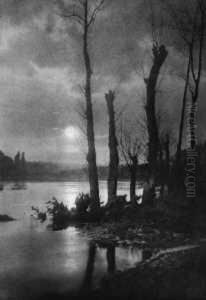Gustave Marissiaux Paintings
Gustave Marissiaux was a notable Belgian photographer born in 1872 in Liège, Belgium. His contribution to the field of photography during the late 19th and early 20th centuries is significant, particularly in the context of pictorialism, a movement that emphasized the aesthetic qualities of photography. Marissiaux's work is characterized by its artistic approach, often focusing on mood, texture, and composition, thus elevating photography to the realm of fine art during a period when its artistic value was still a subject of debate.
Marissiaux initially studied mining engineering before dedicating himself to photography around the turn of the century. His transition to photography was influenced by the pictorialist movement, which sought to apply the principles of painting and printmaking to the photographic process. He became a prominent member of several photographic societies, including the influential Linked Ring in Britain and the Photo-Club de Paris, which played crucial roles in promoting photography as an art form. Marissiaux's work was widely exhibited across Europe and received considerable acclaim for its technical skill and artistic sensibility.
Throughout his career, Marissiaux explored various subjects, including landscapes, urban scenes, portraits, and still lifes, always with a keen eye for light and composition. His photographs often possess a lyrical quality, using soft focus and innovative printing techniques to create evocative and atmospheric images. He was also among the early photographers to experiment with autochrome, an early color photography process, further showcasing his innovative spirit.
Gustave Marissiaux's career was not just limited to creating art; he also wrote articles and essays on photography, contributing to the intellectual discourse surrounding the medium. His writings and photographs helped to articulate a vision for photography that was both deeply personal and universally resonant, advocating for its recognition as a legitimate and powerful form of artistic expression.
Sadly, Marissiaux's career was relatively short-lived, and he passed away in 1929. Despite this, his legacy endures, and he is remembered as a pioneering figure in the development of artistic photography. His work continues to be studied and admired for its beauty, technique, and innovative approach, securing his place in the history of photography as an artist who truly understood and exploited the medium's potential to capture and convey the subtleties of the human experience and the natural world.

